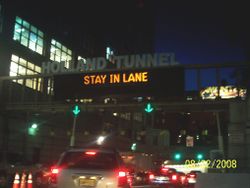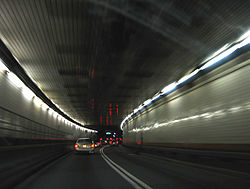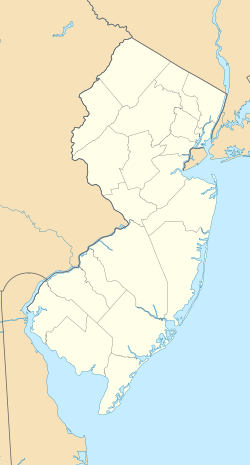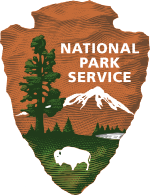Holland Tunnel
|
||||||||||||||||||||||||||||
|
||||||||||||||||||||||||||||
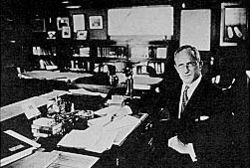
Clifford Milburn Holland, 1919
|
||||||||||||||||||||||||||||
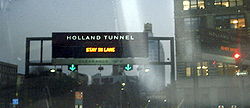
Holland Tunnel entrance from New York City.
|
||||||||||||||||||||||||||||

New York Land Ventilation Building south side
|
||||||||||||||||||||||||||||
The Holland Tunnel is a highway tunnel under the Hudson River connecting the island of Manhattan in New York City with Jersey City, New Jersey at Interstate 78 on the mainland. Unusual for an American public works project, it is not named for a government official, politician, or local hero or person of historical interest, but for its first chief engineer. The tunnel was originally known as the Hudson River Vehicular Tunnel or the Canal Street Tunnel and, along with the Lincoln Tunnel, is one of two highway tunnels under the Hudson River.
Contents |
Description
Begun in 1920 and completed in 1927, the tunnel is named after Clifford Milburn Holland (1883–1924), Chief Engineer on the project, who died before it was completed. Famed tunnel designer Ole Singstad finished Holland's work. The tunnel is one of the earliest examples of a ventilated design, having 80-foot-diameter (24 m) fans providing transverse air flow across the roadway at regular intervals, via systems of ducts. Ventilation was required by the advent of the automobile and associated exhaust.[4]
The tunnel consists of a pair of tubes, each providing two lanes in a 20-foot (6 m) roadway width and 12.5 feet (3.8 m) of headroom. The north tube is 8,558 feet (2,608 m) from end to end, while the south tube is slightly shorter at 8,371 feet (2,551 m).[5] Both tubes are situated in the bedrock beneath the river, with the lowest point of the roadway approximately 93 feet (28 m) below mean high water.
The amount of traffic at the Holland Tunnel has remained steady in recent years, despite tight restrictions on eastbound traffic in response to the September 11 attacks, including a ban on commercial traffic entering New York City, put in place after an August 2004 threat.[6][7] The tunnel was used by 34,698,000 vehicles in 2007,[5] according to the Port Authority of New York and New Jersey — the bi-state government agency that owns and operates the Holland Tunnel and several other area bridges, tunnels, and airports. That is slightly less than the 34,729,385 vehicles seen in 2006, but up from the 33,964,000 vehicles in 2005.
The tunnel was designated a National Historic Civil and Mechanical Engineering Landmark in 1982[8] and a National Historic Landmark in 1993.[9][10][11]
Boyle Plaza
The approach to the Holland Tunnel in Jersey City begins where the Lower Level of NJ 139 and the Newark Bay Extension meet. On May 6, 1936, the section of NJ 139/I-78 between Jersey Avenue and Marin Boulevard was named in memory of John F. Boyle, the former interstate tunnel commissioner.[12] Boyle Plaza is the only segment of I-78 and NJ 139 that has stoplights, as it runs concurrent with 12th Street (the eastbound lanes) and 14th Street (the westbound lanes) in Jersey City.
The nine-lane toll plaza is equipped with E-ZPass (first made available in October 1997).[13][5] As of 2008[update], the cash toll for passage from New Jersey to New York is $8 for cars and $7 for motorcycles (there is no toll going to New Jersey). Vehicles equipped with an E-ZPass receive a discount during off-peak hours ($6 for cars, $5 for motorcycles).[14]
History
Passage across the lower Hudson River was only by ferry for centuries. The first tunnels to be bored below the Hudson River were the Hudson & Manhattan Railroad's uptown and downtown tunnels, constructed in the first decade of the 20th century to link the major railroad stations in New Jersey with Manhattan Island. The Pennsylvania Railroad's twin tunnels, constructed to serve the new Pennsylvania Station, soon followed. Once tunnelling had been shown to be feasible, increasing automobile traffic led to interest in a roadway crossing the river as well.
The concept for what would become the Holland Tunnel was developed in 1906 by a joint commission between New York and New Jersey. The commission initially considered building a bridge for cost reasons, but this plan was abandoned in favor of a tunnel in 1913 when it was determined that the cost of land for accessways to a suitably raised bridge would be prohibitive (a height of 200 feet (60 m) was considered the minimum necessary to avoid interfering with shipping.)[15]
Over the next several years, a number of design proposals were evaluated for the new tunnel. The first two called for a single tube containing two levels of traffic. One, authored by engineer George Goethals specified that traffic on each level would travel in a different direction. The other, by the firm Jacobs and Davies, called for a slightly different tube diameter, with an "express" level and a level for slower traffic. Both designs were eventually passed over in favor of a new type of design proposed by engineer Clifford Milburn Holland, in which two separate tubes would each contain two lanes both going in the same direction. Holland's proposal was adopted, and he was named Chief Engineer of the project.[16] Promotional materials compared the diameter and capacity of the proposed tunnel with the smaller-diameter railroad tunnels.
Work on the tunnel, officially designated the "Hudson River Vehicular Tunnel Project", began on March 31, 1922, with a gang of workers starting digging at the corner of Canal Street and West Street.[17] On October 27, 1924, the day before the two halves of the tunnel were scheduled to be linked, 41-year-old Holland died of a heart attack in a sanatorium in Battle Creek, Michigan, attributed by individuals cited in The New York Times to the stress he endured overseeing the tunnel's construction. "Holing through" ceremonies scheduled for that day, in which President Calvin Coolidge would have remotely set off an explosion to connect the two sides of the tunnel, were canceled out of respect for Holland's death.[18] The project was renamed the Holland Tunnel in memory of its first chief engineer by the New York State Bridge and Tunnel Commission and the New Jersey Interstate Bridge and Tunnel Commission on November 12, 1924.[8] Holland was succeeded by Milton H. Freeman, who died of pneumonia in March 1925, after several months heading the job.[19] After Freeman's death, the position was occupied by Ole Singstad, who oversaw the completion of the tunnel and designed its pioneering ventilation system.[20]
Construction
Tunnel construction required workers to spend large amounts of time in the caisson under high pressure of up to 47½ pounds per square inch, which was necessary to prevent river water from entering prior to completion of the tubes. "Sandhogs", as they were termed, entered the tunnel through a series of airlocks, and could only remain inside of the tunnel for a designated time period. On exiting the tunnel, the workers were required to undergo controlled decompression in order to avoid the bends, a condition in which nitrogen bubbles form in the blood.[21] Fortunately, no workers died as a result of decompression sickness: the work involved "756,000 decompressions of men coming out of the compressed air workings," which resulted in 528 cases of the bends, none fatal.[22][23]
Ventilation system
The most significant design aspect of the Holland Tunnel is its pioneering ventilation system. At the time of its construction, underwater tunnels were a well-established part of civil engineering, but no long vehicular tunnel had been built: the technical hurdle was the ventilation required to evacuate the carbon monoxide emissions, which would otherwise asphyxiate the drivers.[23][24][25][26][27][28][29]
Thomas Edison had contended it was impossible to ventilate a tunnel with the volume of traffic envisioned for the Holland Tunnel.[30] Previously, tunnels had been ventilated longitudinally. Engineer Ole Singstad pioneered a system of ventilating the tunnel transversely.
Working with the Yale University and United States Bureau of Mines, Singstad built a test tunnel in the bureau's experimental mine at Bruceton, Pennsylvania over 400 feet (120 m) long — where cars were lined up with engines running. Volunteer students were supervised as they breathed the exhaust in order to confirm air flows and tolerable carbon-monoxide levels by simulating different traffic conditions, including backups. Singstad concluded that a conventional, longitudinal ventilation system would have to be pressurized to an air flow rate of 27 metres per second (89 ft/s) on along the tunnel.[30]
Singstad confirmed the feasibility of a tri-level tunnel with the large middle section accommodating vehicles and two plenums, a lower and upper plenum each respectively supplying fresh air and exhausting fumes at regular intervals — solving the ventilation problem.[30]
On opening day the average carbon monoxide content in both tunnels was .69 part per 10,000 parts of air. The highest was 1.60 parts per 10,000. The permissible standard was 4 parts per 10,000 parts of air.[31] The public and the press proclaimed air conditions were actually better in the tube than in some streets of New York City.[31]
Operation
Completion of the tunnel took nearly seven years, and claimed the lives of fourteen workers. The tunnel opened on November 13, 1927, with President Coolidge pressing a golden lever that triggered American flags on both sides of the tunnel to separate. Vehicles were allowed to pass through the tunnel at one minute after midnight, with the widows of Chief Engineers Holland and Freeman in the second toll-paying vehicle.[4] The tunnel was an immediate success. On its first day of operation, 51,694 vehicles passed through, paying a 50 cent toll ($6.19 in 2009 dollars) per car (25 cents for a motorcycle and truck tolls of up to two dollars), which was intended to defray the tunnel's $48 million price tag.[4][32] In 1930 the tunnel was passed to the Port Authority of New York and New Jersey, which continues to operate it today.[33] Excluding the initial $48 million in construction, the Port Authority notes $536,600,000 of cumulative capital investment as of December 31, 2005.
Horse-drawn vehicles have always been banned from the tunnel. A few months before the tunnel's opening, there were suggestions that pedestrians would be allowed to cross the tunnel if they paid a toll described as "not encouraging", but no further mention of this was ever made.[34]
Recent changes
Between 2003 and 2006 the fire protection system in both tunnels was modernized. Temporary fire extinguishers were located in alcoves along the tunnel walls while the water supply was turned off.[35]
Accidents and terrorism
In 1949, a fire aboard a chemical truck caused enormous damage to the south tube of the tunnel.[36] Although nobody was killed, the fire resulted in 66 injuries and nearly $600,000 worth of damage to the structure. As a result, the Port Authority adopted a strict series of rules on the transportation of hazardous materials within the tunnel.
Following the September 11, 2001, terrorist attacks on the World Trade Center, the tunnel remained closed to all but emergency traffic for nearly a month. When it reopened on October 15, 2001, strict new regulations were enacted banning single-occupant vehicles and trucks from entering the tunnel.[37] Single occupant vehicles were prohibited in the tunnel on weekday mornings between 6:00 am and 10:00 am until November 17, 2003, when the restrictions were lifted.[38] Commercial vehicles in classes 1, 2 and 3 (two and three-axle single-unit trucks) are permitted to travel in both directions of the tunnel at all times. The ban on tractor-trailers and larger trucks in classes 4, 5 and 6 (four, five and six-axle trucks) remains in effect in both directions at all times. The ban on trailers and towed vehicles remains in effect in both directions at all times.
Cell phone service was turned off after a series of terrorist bombings occurred in London on July 7, 2005, but was reinstated a few days later.
On July 7, 2006, a plot to detonate explosives in the tunnels of the Port Authority Trans-Hudson (initially said to be a plot to bomb the Holland Tunnel) was uncovered by the Federal Bureau of Investigation. In a later update of the source,[39] the plot was clarified to be aimed not at the Holland Tunnel but at the PATH rail system between New York and New Jersey.
Cultural references
- On an episode of Saturday Night Live, Dan Aykroyd and Steve Martin are told by two women in their apartment building to meet them at the Holland Tunnel.
- Although the tunnel in the 1996 Sylvester Stallone movie Daylight is never named (potentially to avoid libel accusations by the Port Authority), the movie is set in a tunnel based on the Holland Tunnel.[40]
- The Holland Tunnel is mentioned in the film Something Wild (1986) just before the protagonists drive through it.
- In the film Working Girl (1988) it is mentioned that a truck got stuck in the Holland Tunnel.
- A stolen car in a park near the Holland Tunnel in New Jersey provides a plot point in US Marshals (1998).
- In The War Within (2005), a character notes that the road they are on takes them right into the Holland Tunnel.
- In the remake Alfie (2004), the title character notes that a particular female has "cleavage like the Holland Tunnel".[41]
- In an episode of I Love Lucy, it is mentioned that Lucy, while learning to drive, attempted to make a U-turn in the Holland Tunnel, thus blocking traffic all the way to East Orange, New Jersey.[42]
- In the video game Grand Theft Auto III, the Holland Tunnel is parodied, named "Porter Tunnel".
- In the video game Grand Theft Auto IV, the Holland Tunnel and Lincoln Tunnel is also parodied, named "Booth Tunnel".
- Singer John Phillips recorded a song called "Holland Tunnel" on his John, Wolf King of L.A. album.[43]
- In the film The Day After Tomorrow, the tunnel is sealed off due to wide spread flooding.
- The electronica trio The New Deal recorded a song called "Holland Tunnel" on their live album This Is Live.
- The New York based No Wave outfit impLOG recorded a 12-inch (300 mm) track called Holland Tunnel Drive.
- In the 1953 horror film The Deadly Mantis, the giant insect is finally killed with nerve gas when it hides in Holland Tunnel.
- Hoboken, New Jersey alternative rock band Yo La Tengo's 1997 album I Can Hear the Heart Beating as One features a photo of the New York entrance to the Holland Tunnel on the cover.
- In the book On the Road, by Jack Kerouac, the main character makes use of the tunnel on his journey to the Western United States.
- New Zealand pop band The Mockers' second album is called Living in the Holland Tunnel and features a picture of cars driving into the tunnel entrance on the cover.
- In the NBC show Mercy, which is set in New Jersey, a sign for the tunnel is in the opening credits.
References
- ↑ "Tolls - Bridges & Tunnels". Port Authority of New York and New Jersey. http://www.panynj.gov/bridges-tunnels/tolls.html. Retrieved March 13, 2010.
- ↑ "2008 NYSDOT Traffic Data Report" (PDF). New York State Department of Transportation. Appendix C. https://www.nysdot.gov/divisions/engineering/technical-services/hds-respository/NYSDOT_TDR_Appendix_C.pdf. Retrieved February 27, 2010.
- ↑ "National Register Information System". National Register of Historic Places. National Park Service. April 15, 2008. http://www.nr.nps.gov/.
- ↑ 4.0 4.1 4.2 "Science: Holland Tunnel". Time. November 21, 1927. http://www.time.com/time/magazine/article/0,9171,786201,00.html. Retrieved September 25, 2008.
- ↑ 5.0 5.1 5.2 Holland Tunnel Statistics, Port Authority of New York and New Jersey. Accessed September 25, 2008.
- ↑ Weekly Traffic Advisory, Port Authority of New York and New Jersey. Accessed September 25, 2008.
- ↑ McFadden, Robert D.; Dao, James (August 3, 2004). "THREATS AND RESPONSES: THE OVERVIEW; At 5 Buildings, A Day of Pluck And Patience". The New York Times. http://www.nytimes.com/2004/08/03/world/threats-and-responses-the-overview-at-5-buildings-a-day-of-pluck-and-patienc.html?pagewanted=all. Retrieved September 25, 2008.
- ↑ 8.0 8.1 "Holland Tunnel". ASCE Metropolitan Section. http://www.ascemetsection.org/content/view/333/866/. Retrieved January 18, 2009.
- ↑ "Holland Tunnel National Historic Landmark summary listing". National Park Service. September 11, 2007. http://tps.cr.nps.gov/nhl/detail.cfm?ResourceId=2176&ResourceType=Structure.
- ↑ Lange, Robie, S. (March 1993). "Holland Tunnel National Historic Landmark Nomination" (PDF). National Park Service. http://pdfhost.focus.nps.gov/docs/NHLS/Text/93001619.pdf.
- ↑ "Holland Tunnel National Historic Landmark Nomination--Accompanying 12 photos, from 1927-1992" (PDF). National Park Service. March 1993. http://pdfhost.focus.nps.gov/docs/NHLS/Photos/93001619.pdf.
- ↑ "Boyle Plaza Dedicated". The New York Times: p. 26. May 6, 1936. http://select.nytimes.com/gst/abstract.html?res=F10D17F7385B1B7B93C4A9178ED85F428385F9. Retrieved May 29, 2010.
- ↑ Halbfinger, David M. (October 27, 1997). "E-Z Pass to Start at Hudson River Tunnels". The New York Times. http://query.nytimes.com/gst/fullpage.html?res=9C07EEDB1731F934A15753C1A961958260. Retrieved September 25, 2008.
- ↑ Tolls Information, Port Authority of New York and New Jersey. Accessed September 25, 2008.
- ↑ Holland Tunnel Historical Photos, Port Authority of New York and New Jersey. Accessed September 25, 2008.
- ↑ Holland Tunnel Historic Overview, nycroads.com. Accessed September 25, 2008.
- ↑ "Work Begins Today on Jersey Tunnel". The New York Times: p. 18. March 31, 1922. http://query.nytimes.com/gst/abstract.html?res=9501E4DA1639EF3ABC4950DFB5668389639EDE. Retrieved May 29, 2010.
- ↑ "C. M. Holland Dies After Breakdown". The New York Times: p. 23. October 28, 1924. http://select.nytimes.com/gst/abstract.html?res=F00E11F63C5B12738DDDA10A94D8415B848EF1D3. Retrieved May 29, 2010.
- ↑ "Another Engineer Dies on Big Tunnel Job; M.H. Freeman Is Victim of Acute Pneumonia". The New York Times: p. 1. March 26, 1925. http://select.nytimes.com/gst/abstract.html?res=F30811F63B5C17738DDDAF0A94DB405B858EF1D3. Retrieved May 29, 2010.
- ↑ Krebs, Albin (December 9, 1969). "Ole Singstad, 87, Master Builder Of Underwater Tunnels, Is Dead". The New York Times. http://select.nytimes.com/gst/abstract.html?res=F70D17F939581B7493CBA91789D95F4D8685F9. Retrieved May 29, 2010.
- ↑ Kindwall EP (1997). "Compressed air tunneling and caisson work decompression procedures: development, problems, and solutions". Undersea Hyperb Med 24 (4): 337–45. PMID 9444066. http://archive.rubicon-foundation.org/2267. Retrieved March 11, 2009.
- ↑ Singstad, Ole (September 1928). Norwegian-American Technical Journal 1 (3): 1–3, 10
- ↑ 23.0 23.1 Saga in Steel and Concrete, pp. 181-190
- ↑ Saga in Steel and Concrete, pp. 191–202
- ↑ "Studies and Methods Adopted for Ventilating the Holland Vehicular Tunnels". Engineering News-Record 98: pp. 934–939. 1927-06-09
- ↑ "Ventilating the Holland Vehicular Tunnel". Heating and Ventilating Magazine 23 (79). August 1926
- ↑ Singstad, Ole. "Ventilation of Vehicular Tunnels". Proceedings of the World Engineering Congress. 9. pp. 381–399.
- ↑ Davis, A. C. (October 1930). "Development of the ventilation system of the Holland Tunnel". Heating, Piping and Air Conditioning 2: pp. 866–874
- ↑ Fieldner, A.C.; Henderson, Y.; Paul, J.W.; others (February 1927). Ventilation of vehicular tunnels (Report of U.S. Bureau of Mines to New York State Bridge and Tunnel Commission and New Jersey State Bridge and Tunnel Commission). American Society of Heating and Ventilating Engineers
- ↑ 30.0 30.1 30.2 "Ingeniør Ole Singstad (1882 - 1969)" (in Norwegian). Historier.Norway. http://www.lotsberg.net/artiklar/Singstad.html.
- ↑ 31.0 31.1 "Saga in Steel and Concrete: Norwegian Engineers in America". 1947. http://archiver.rootsweb.ancestry.com/th/read/NORWAY/2003-05/1051983030.
- ↑ Barron, James (June 27, 1994). "A Tunnel? Holland Named U.S. Historic Landmark". The New York Times. http://www.nytimes.com/1994/06/27/nyregion/a-tunnel-holland-named-us-historic-landmark.html. Retrieved September 25, 2008.
- ↑ "History - Holland Tunnel". Port Authority of New York and New Jersey. http://www.panynj.gov/bridges-tunnels/holland-tunnel-history.html. Retrieved May 29, 2010.
- ↑ "Holland Tube Roadways Involve a Huge Task". The New York Times: p. XX10. August 21, 1927. http://select.nytimes.com/gst/abstract.html?res=F50D16FF395D13728DDDA80A94D0405B878EF1D3. Retrieved May 29, 2010.
- ↑ Port Authority of New York and New Jersey (October 14, 2004). "Traffic Advisory - Holland Tunnel Rehabilitation Work to Begin Monday, October 18". Press release. http://www.panynj.gov/AboutthePortAuthority/PressCenter/PressReleases/PressRelease/index.php?id=585. Retrieved September 25, 2008.
- ↑ Spiegel, Irving (May 14, 1949). "Chaotic Scenes in Tunnel Described by the Injured; Views Inside the Holland Tunnel Following Chemical Explosion and Series of Fires Yesterday". The New York Times: p. 1. http://select.nytimes.com/gst/abstract.html?res=FB081EFB3859157A93C6A8178ED85F4D8485F9. Retrieved May 29, 2010.
- ↑ Gilbert, Pat R. (October 16, 2001). "Traffic's a Breeze As Holland Tunnel Reopens". The Record (Hackensack, NJ). http://www.highbeam.com/doc/1P1-47570572.html. Retrieved September 25, 2008.
- ↑ "2003 Manhattan River Crossings" (PDF). New York City Department of Transportation. February 2005. http://www.nyc.gov/html/dot/downloads/pdf/manrivercross03.pdf. Retrieved September 26, 2008.
- ↑ Foreign Plot to Bomb Holland Tunnel Thwarted - Updated, Threat Watch
- ↑ Fleischman, Joan (April 7, 1995). "SLY: 'MOVE' HOLLAND TUNNEL TO MIAMI -- FOR MOVIE". The Miami Herald.
- ↑ Alfie Script - Dialogue Transcript, Script-o-rama. Accessed September 26, 2008. "I mean, have a look. Beautifully preserved. And cleavage like the Holland Tunnel."
- ↑ Gates, Anita (October 14, 2001). "Television/Radio: The Good, the Bad, the Lucy: A Legacy of Laughs; Endlessly Lovable, But Damaging, Too". The New York Times. http://www.nytimes.com/2001/10/14/arts/television-radio-good-bad-lucy-legacy-laughs-endlessly-lovable-but-damaging-too.html?pagewanted=all. Retrieved September 26, 2008.
- ↑ Appleyard, Brian (July 23, 2006). The Times (London). "John Phillips's Holland Tunnel is a wry plea to his girl to use the ultimate road trip, westward across the whole country, to get back to him, the Wolfking, lounging in LA"
External links
- Port Authority of New York & New Jersey: Holland Tunnel
- Holland Tunnel from NYCRoads.com
- The Holland Tunnel, New York Daily News, Wednesday, February 25th 2009
|
||||||||||||||
|
||||||||||||||||||||||||||||
|
|||||||||||
|
|||||||||||||||||
